A Unique One-Day Itinerary in Amsterdam
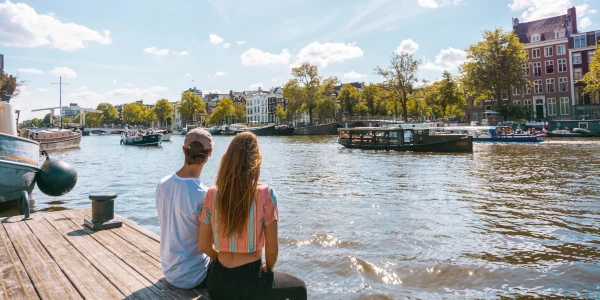
Amsterdam attracts thousands of tourists every year and we can see why. The capital of the Netherlands is just beautiful. We love strolling along the canals, enjoying the historic buildings and the iconic houseboats. In this blog, we’re bringing you with us on a one-day trip in Amsterdam. If you only have one day to spend in Amsterdam, this guide makes sure you’ll see the best and most unique sightseeing spots of Amsterdam. We skip the touristy places like the Dam Square and the Red Light District, but we’re showing you a different, unique and beautiful side of Amsterdam. We have to mention that this guide is packed with activities and we started the day very early at sunrise. If you have multiple days in Amsterdam, you can take it a bit slower and spread these sightseeing spots out over a few days.
Please note that a lot of places mentioned in this blog are currently closed because of the pandemic. We don’t advise anyone to travel when it’s not safe. Use the information in this blog to plan future trips.
Gingerbread houses at Damrak
We’re starting the day at Damrak. You can find gingerbread houses along the canals everywhere in Amsterdam, but the houses at Damrak are the most popular ones. If you want to take a photo right in front of the houses, you have to be early. Damrak is located exactly between Amsterdam Central Station and Dam Square and it’s always very crowded throughout the day. If you can’t go early there’s another spot where you can take a photo any time of the day. On the bridge next to Damrak, you can get down the stairs to a platform close to the water. You have to climb the railings of the bridge and probably a few bikes, but it’s a beautiful spot as well. Most of the time there are no people on this platform.
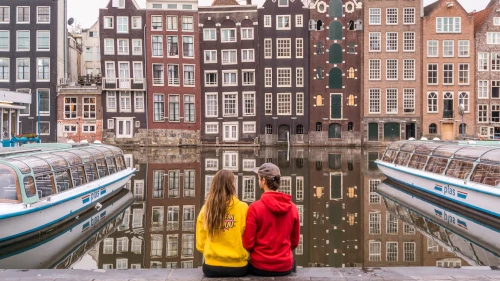

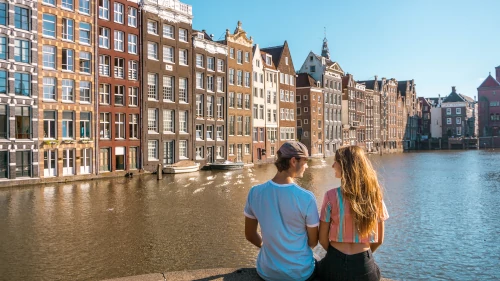
Jordaan
From the Damrak, we’re going to walk to the Jordaan district, which is a lovely district near the city center to stroll around in. The Jordaan was built early in the 17th century and many immigrants and working class people lived in the district. The Jordaan used to be a poor district, but nowadays it’s quite expensive to live here. The original working class people moved years ago to other districts in Amsterdam or cities outside of Amsterdam. The Jordaan is filled with history and beautiful historic monuments. You can also find lots of nice cafés and restaurants here.
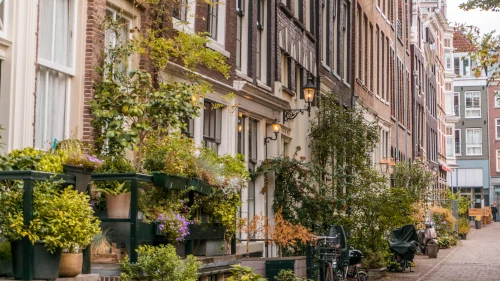
Papiermolensluis
The first place we’re visiting in the Jordaan district is the Papiermolensluis, which is a famous Instagrammable spot. Three canals come together at the Papiermolensluis and it’s one of the busiest waterways of the city. Fun fact: the name “Papiermolensluis” (literally translated to Paper Mill Sluice) descends from a paper merchant’s sign saying “Papiermolen”. The bridge is named after that sign. Be sure to take a photo from the famous photo spot with the Papiermolensluis text on the bridge. You can find this spot at the crossing of Brouwersgracht and Korte Prinsengracht, overlooking the café “Het Papeneiland” from across the canal.
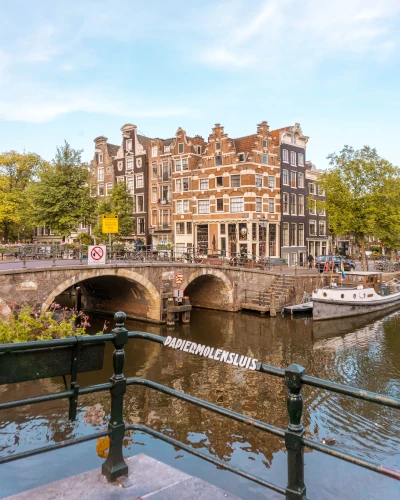
Westerkerk
From the Papiermolensluis, we’re walking to the Westerkerk (literally translated to West Church). It’s a renaissance styled church and the construction took place between 1620-1631. In Anne Frank’s diary, the Westerkerk is mentioned a few times as she could hear the bells ring from her hiding place. The house where Anne Frank hid with her family is very close to the church. This house is now a museum and is known as the Anne Frank House. It’s a very interesting place and a must-visit if you’re staying longer than 24 hours in Amsterdam. Be sure to get your tickets beforehand because it’s always crowded. Check this website for more information about the Anne Frank House.
It’s possible to visit the Westerkerk and see the inside of the church or to climb the Westertoren (West Tower) for a beautiful view over Amsterdam. We’re not going to do that as we’re limited on time. We’re admiring the Westerkerk from the Kees de Jongenbrug on the other side of the canal. This is a perfect photo spot of the Westerkerk.
Opening hours Westerkerk:
Monday-Friday: 10.00-15.00
Opening hours Westertoren:
April-September: 09.00-20.30
October: 09.00-18.00
Tours start every 30 minutes. The price of a tour is €9,– per person. Check this website for more information.
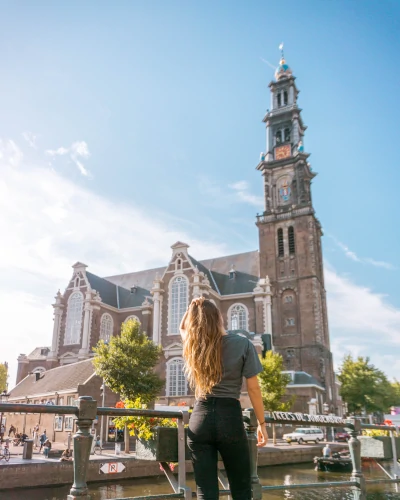
Begijnhof
From the Kees de Jongenbrug, we’re walking to the Begijnhof. A “hofje” is a courtyard surrounded by small houses. Hofjes often provided housing for elderly people, they were privately funded and used as a form of social security. Most of the hofjes in the Netherlands are built between the 13th and 19th century. Many historic cities still have a few of them left, mostly in the provinces North and South-Holland. Nowadays, many of the still existing hofjes are inhabited. However, it’s not free anymore to live in a hofje. In many cities, hofjes have become private property.
Begijnhof in Amsterdam is the only hofje that was built in medieval Amsterdam. It’s not a regular hofje as described before, since it didn’t provide housing for elderly people. The use of Begijnhof was similar to a monastery, however the “begijnen” (the inhabitants of the “Begijnhof”) were given more liberties than nuns. Unlike regular hofjes, Begijnhof features large, individual houses.
Despite the differences with regular hofjes, Begijnhof is absolutely worth a visit. Begijnhof is located in the middle of the city center and even though it’s in the middle of a busy shopping district, it feels like an oasis of peace when you’re in the courtyard. It’s a unique place to see a glimpse of medieval Amsterdam. A part of the Begijnhof is closed to safeguard peace for the inhabitants.

Amsterdam Flower Market
Not far from the Begijnhof, you can find the Flower Market. Even though the Flower Market isn’t really a unique sightseeing spot, it’s still a must-visit in Amsterdam. All stands of the Flower Market are located on the water and it’s the only floating flower market in the world. You don’t really notice that it’s a floating market though when wandering through the stands. It feels just as if you’re walking on the streets.
At the Flower Market you’ll find all kinds of fresh flowers, flower bulbs, flower seeds, fake flowers and typical Dutch souvenirs like clogs. If you want to enjoy the famous Dutch tulips at home, this is the place to buy tulip bulbs. As you’re not allowed to bring bulbs with you on a plane, the bulbs will be exported to your house address abroad. Even if you’re not interested in buying souvenirs, it’s a lovely market to walk around and to enjoy the blooms.
Opening hours:
Monday-Saturday: 09.00-17.30
Sunday: 11.30-17.30
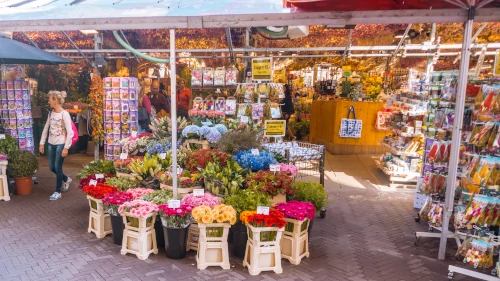
Stroopwafels
Stroopwafels (or caramel waffles) are a famous Dutch treat and they’re delicious. Dutch people typically buy the waffles warm at local farmers’ markets. Close to the Flower Market, you can find Van Wonderen Stroopwafels which serves fresh stroopwafels dipped in chocolate and covered with toppings such as M&Ms, nuts or cookie crumbles. The stroopwafels look amazing and are a must if you want to get that iconic stroopwafel photo overlooking the canals. If you prefer a more traditional stroopwafel experience, you can get a fresh one at one of the farmer’s markets in Amsterdam. The Albert Cuyp market, for instance, is a daily market that’s open from 09.00-17.00 (except on Sundays).
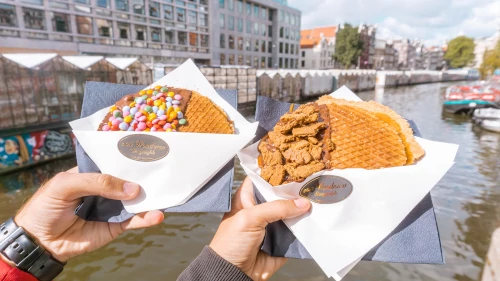
Magere Brug
From the Kalverstraat, we’re going to walk to the Magere Brug. As there are many canals in Amsterdam, there are also many bridges. One of the prettiest bridges is the Magere Brug (or Skinny Bridge). The Magere Brug is a drawbridge and it’s a perfect photo spot during the day or night. At night, the bridge is filled with lights which looks very pretty. The surrounding area of the Magere Brug is lovely as well with lots of gingerbread houses along the Amstel river. In this area, you can also find the Hermitage Museum and some more pretty drawbridges (for instance the Walter Süskind Bridge). We can really recommend wandering around this area.
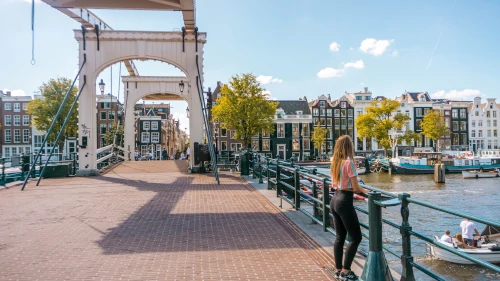
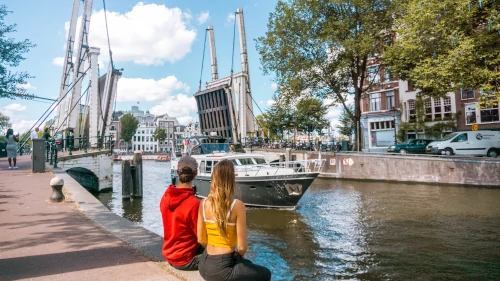
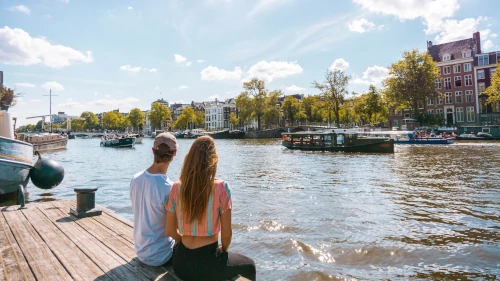
Hortus Botanicus
Not far away from the Magere Brug, you can find the Hortus Botanicus. The Hortus Botanicus is Amsterdam’s botanical garden with over 6000 tropical and native trees and plants. The Hortus Botanicus was founded in 1638 as “Hortus Medicus” and served as an educational place for doctors and pharmacists. It’s a really nice garden to walk around in and we especially loved the greenhouses. There is even a butterfly greenhouse, with different kinds of butterflies flying around. If you’re into plants and flowers you should really check this botanical garden out.
Opening hours:
Daily from 10.00-17.00
Entrance fee: €9,75 (adult)
Read more about the Hortus Botanicus: Virtual Tour of the Hortus Botanicus in Amsterdam
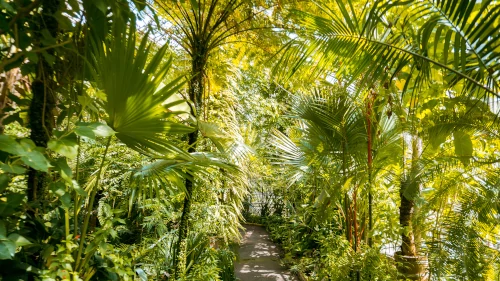

Zevenlandenhuizen
From the Hortus Botanicus, we’re going to walk to the Roemer Visscherstraat where you can find the Zevenlandenhuizen. The Zevenlandenhuizen (7 Country Houses) are 7 houses (nr. 20 to 30A) and every house is inspired by a different European country. The houses are built in 1894 by architect Tjeerd Kuipers. The countries represented by the houses are: Germany (nr. 20), France (nr. 22), Spain (nr. 24), Italy (nr. 26), Russia (nr. 28), the Netherlands (nr. 30) and England (nr. 30A). The Zevenlandenhuizen are a unique sightseeing spot in Amsterdam and it’s interesting to see the different styles of the houses. It’s a lovely photo spot too!
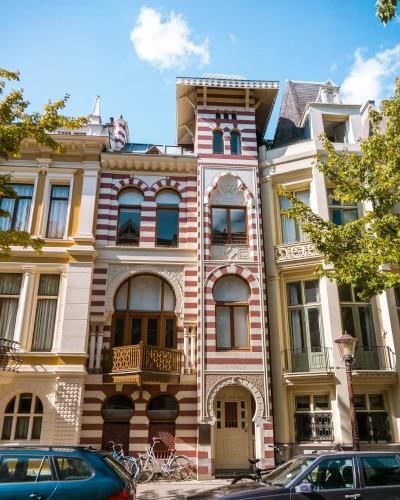
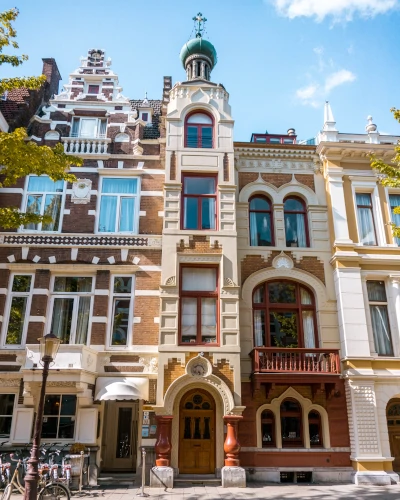
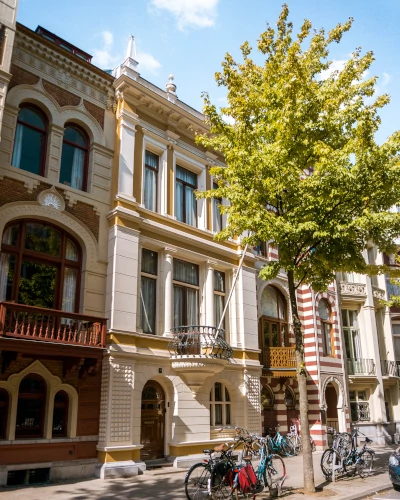
Rooftop Bar SkyLounge
From the Zevenlandenhuizen, we’re going to walk all the way back to the Amsterdam Central Station area, where we also started the day. The SkyLounge is located at the 11th floor of the Double Tree Hilton hotel at Amsterdam Central Station. The rooftop bar offers a beautiful view over Amsterdam. It’s a nice place to have drinks when the weather is good. When the weather is not that good, it’s still worth to quickly take a photo of the view. You can just walk into the hotel and follow the signs to the rooftop bar. Visiting the SkyLounge is a perfect way to end your day in Amsterdam.
Opening hours:
Sunday-Tuesday: 11.00-01.00
Wednesday & Thursday: 11.00-02.00
Friday & Saturday: 11.00-03.00
There’s no entrance fee to the rooftop.
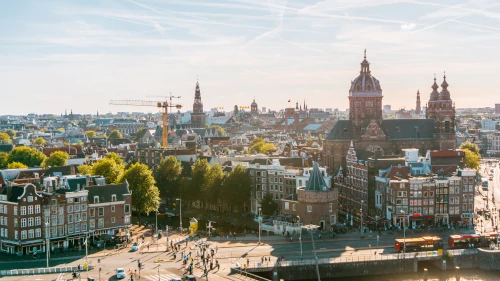
We hope you’ve enjoyed this one-day itinerary of Amsterdam filled with unique sightseeing spots. This itinerary is perfect if you’re visiting Amsterdam by train as the day starts and ends close to Amsterdam Central Station. But also if you’re staying in Amsterdam, this unique one-day itinerary is perfect for you. We hope you were able to see a unique and beautiful side of Amsterdam, one that you probably won’t see if you’re just following the tourist guides.
Is Amsterdam on your bucket list? Let us know in the comments below!
Be sure to check out:
- our daily life updates on Instagram
- our Stuck at Home vlog series on YouTube
- our TikTok
More The Netherlands
The Most Instagrammable Places in Amsterdam
Tulip Fields in the Netherlands - A Photo Guide with Locations
Virtual Tour of the Tulip Fields in the Netherlands

